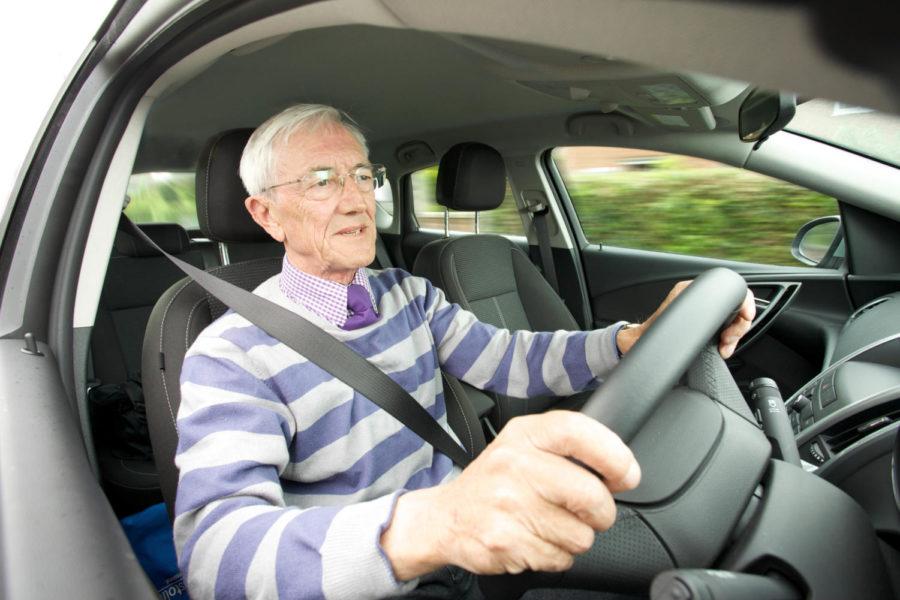Gross: The problem with aging drivers
The elderly make up 9 percent of the U.S. population, but they account for 14 percent of all traffic fatalities and 17 percent of all pedestrian fatalities, according to the National Highway Traffic Safety Administration.
December 11, 2013
Before we are allowed to get our drivers’ licenses at the age of 16, most of us have to undergo various tests of knowledge. Some actually have to take in-car driving tests, proving their aptitude. The idea behind this is that young people, who have not driven much, need to be tested in order to maintain relative safety on the roads.
A similar thought process is used by those who argue for driving tests to be taken by older people. The elderly — with potentially impaired vision or cognitive thinking — can make for unsafe drivers just as teenagers — with their rash actions and undeveloped brains — can. This problem continues to grow, as advancements in medical science lead to a larger population of older people than ever before.
The elderly make up 9 percent of the U.S. population, but they account for 14 percent of all traffic fatalities and 17 percent of all pedestrian fatalities, according to the National Highway Traffic Safety Administration. Additionally, the safety administration claims that the population of older adults has increased by 20 percent since 2003. Of course, not all older drivers are bad, and by no means are all young drivers good. This disproportion, however, needs to be taken care of.
It is important to many that they stay independent and functioning as they age; few want to be declared unfit to live or travel alone. However, it is also important that roads stay safe for drivers of all age groups. According to the Centers for Disease Control and Prevention, fatal crash rates grow dramatically when people reach the age of 75 and increase again at 80 years old. This is due in part to the elderly’s lesser ability to recover after physical trauma. Nevertheless it can be truthfully said that older age groups can be dangerous to themselves and others.
There are ways that older drivers can help protect themselves, as listed on the CDC website, but some would argue for federal intervention as well. It may seem cruel to enact sudden laws limiting the driving abilities for the elderly, but it would surely do away with the problem.
More commonly heard is an argument for the middle ground where drivers should have their driving ability tested at a certain age. While perhaps not the most dignified for many elderly who are in perfectly great physical and mental shape, this would keep those who are not qualified off of the road. If it can be said that some are too young to drive well, then why can’t we also argue that some are too old? No one’s rights should be taken away with sweeping, restrictive legislation, but installing regular testing might just save lives.
Fortunately, it seems that the federal government is moving in the right direction. Over the weekend, USA Today reported that a five-year strategic plan for elderly driving has been started by the National Highway Traffic Safety Administration. The plan does not include any new pushes for restricting legislation but rather lays the foundation necessary for such endeavors.
One part of this new plan is to update vehicle safety technologies, and attempt to make cars safer to drive than they are now. This includes things like vehicle-to-vehicle communications and other advanced technology that can now be used to avoid accidents. A second part of this plan is a focus on driver behavior and driving methods. This part is meant to educate the public on driving dangers, especially related to the elderly. Additionally, they plan to identify issues that the driving community is struggling with, which leads to the third key component of the traffic safety administration’s new plan — research and data collection.
To be able to prove that older drivers need restriction, cold, hard numbers must be provided. Though some facts already exist and are common knowledge, such as the fatalities percentage mentioned earlier, this research needs to be as precise as possible. The data collection will include fatality and crash injury rates, “as well as clinical and naturalistic studies of physical, cognitive and perceptual changes associated with drivers’ behavior as they age.”
These are just the first steps being taken in providing a safer driving environment in America. As stated before, I don’t — and few actually would — advocate entirely restrictive legislation. But it seems fair to say that as the elderly population grows, so should our efforts to ensure that they are capable drivers. By doing preliminary research and planning, the federal government may be able to come up with a solution that does not infringe upon our rights.

















